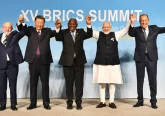 In 1955 G.A. Campbell wrote ‘[s]o long as officials obtained the whole or part of their income from fees, the total cost of the Service remained hidden. Parliament needed to provide no money at all for salaries in some departments, and where revenue did not balance expenditure it voted only for the difference. Under the new arrangements [after 1837] Parliament saw for the first time the wages bill of the public administration. The cost seemed to members of both Houses to be enormous. […] There has never since been a time when Parliament has not thought the Civil Service to be too costly and sought, more or less urgently, for economies in administration.’ (The Civil Service in Britain, Penguin, p. 61)
In 1955 G.A. Campbell wrote ‘[s]o long as officials obtained the whole or part of their income from fees, the total cost of the Service remained hidden. Parliament needed to provide no money at all for salaries in some departments, and where revenue did not balance expenditure it voted only for the difference. Under the new arrangements [after 1837] Parliament saw for the first time the wages bill of the public administration. The cost seemed to members of both Houses to be enormous. […] There has never since been a time when Parliament has not thought the Civil Service to be too costly and sought, more or less urgently, for economies in administration.’ (The Civil Service in Britain, Penguin, p. 61)
So, do we know how much the civil service costs now?
With so many performance metrics and digital data available, one might expect that the cost of the civil service would be easy to find. The number of civil servants is presented in Civil Service Statistics (published annually since 1970) as a continuous data set for the whole 20th century. But the corresponding costs have been much more difficult to determine. Our efforts (as part of our study funded by the Leverhulme Trust) have concentrated on the past 50 years.
Investigative work on finding out civil service paybill costs.
From 1961 to 1985 the civil service paybill was reported annually in the Treasury memoranda. This included the staff employed by central government departments and civilian staff in the Ministry of Defence (MoD). But this data set ended in 1985, when the concept of ‘running costs’ was introduced with the aim of improving efficiency by reporting the costs of all aspects of administration, rather than just salaries.
As a result, the Government’s Expenditure Plans 1986 (the first of the Public Expenditure Statistical Analyses (PESA)) did not mention the paybill, but just ‘running costs’. The first edition to mention the paybill was Public Expenditure Analyses to 1994-95 (Cm 1920 1991-92) (PESA 1992). This showed the civil service paybill backdated to 1986. Thereafter, each successive edition reported the paybill (in the section on central government running costs) for the current and several previous years.
We plotted the paybill figures from all 20 editions of PESA and found several incompatible data sets (Figure 1). The series were named, ‘Civil Service Paybill’, ‘Administration Costs Paybill’ or just ‘Paybill’ (though those titles meant different things at different times). The MoD civilian paybill appeared and disappeared mysteriously over the period. In two editions (1996 and 1997) the ‘paybill’ was nearly double that of previous (and subsequent) reports. A footnote in PESA 1996 stated ‘This covers the pay costs of civil servants and others (including casual staff) covered by running costs plus Ministry of Defence’s operating costs regime’ and we found that (for those years only) the paybill included the whole of the armed forces pay.
Figure 1: What PESA reports.
We managed to disentangle the various definitions and, by including data from MoD annual reports and making some assumptions, we filled in the gaps in Figure 1 to give Figure 2 (costs shown corrected for inflation by dividing by the GDP deflator).
Figure 2. Civil Service Paybill reconstructed from PESA and MoD annual reports, corrected for inflation.
But these calculations still did not produce a straightforward data set. Each PESA edition reported the costs over a few years, but these short runs of data rarely agreed with each other. Indeed the writers of PESA cautioned readers not to compare numbers from different editions ‘due to changes in coverage and classifications’. From the footnotes to the PESA tables we concluded that changes in the treatment of superannuation and temporary or casual staff, as well as changes around the time of devolution and the movement of groups of staff into or out of the civil service, could account for most of the changes from PESA 1992 to 2004. We have developed a method for removing such reclassifications (Hood and Dixon 2012 Public Administration forthcoming) and were then able to put together a consistent data set for the paybill for fiscal years 1986-7 to 2002-03 (the green line in Figure 3).
The Gershon Report
However, in PESA 2005, the reported administration paybill fell by about 20 per cent (backdated in PESA 2006 so that the reduction appeared to date from 2001). This dramatic fall was not mentioned in the text, but a footnote now described the paybill as covering ‘the pay costs of civil servants falling within Administration Budgets.’ At that time some civil servants (such as prison officers and immigration staff) were reclassified as ‘Programme’ rather than ‘Administration’. These reclassifications were attributed to the Gershon report Releasing Resources to the Front Line (HMT 2004). Unfortunately, it’s now not clear which staff are covered by the administration budget (and definitions appear to have changed again in PESA 2011).
National Audit Office Report
So from about 2004, we were not able to find the total cost of the civil service from PESA. Instead, we found a National Audit Office report (Managing Staff Costs in Central Government 2011) giving the costs of the civil service from 2001 to 2010. This series (gratifyingly) agreed closely with our calculations for 2001 to 2003. But the report (which attributes the figures to Cabinet Office estimates) is not part of a series and there’s no guarantee that these numbers will be calculated in the future. We understand from analysts at the NAO that these figures were based on numbers and grades of civil servants and their average salaries (plus estimates of superannuation, national insurance, bonus payments, etc.) – but the underlying data are not all publicly available.
Conclusion
All these data sets are summarized in our final figure, which also shows the number of civil servants since 1961. We come to the not very spectacular conclusion that the civil service costs as much now (in real terms) as it did in the 1970s although the number of staff has dropped by over 40 per cent. So what happened during those years of outsourcing, privatizing, and IT initiatives that allowed the civil service to maintain its share of the cake? However, defenders of civil service frugality would argue that public spending has more than doubled and maybe it’s a success story that civil service costs are stable.
Returning to G.A.Campbell’s observations, we can ask if it is now so difficult to find out what the civil service costs, is the situation similar to the early 19th century when that figure was actually unknowable, and should we be worried about that?
Figure 3. Our estimate of the civil service paybill from 1961 to 2010.
Note: This post is based on data from our study of long-term changes in UK central government, entitled ‘Yesterday’s Tomorrows: Whatever Happened to the Future of Government?’ which is funded by the Leverhulme Trust. For more details see our website http://xgov.politics.ox.ac.uk.
Co-authored by Ruth Dixon and Christopher Hood.
Dr Ruth Dixon is Leverhulme Trust Postdoctoral Researcher.
Professor Christopher Hood is Gladstone Professor of Government, and a Fellow of All Souls College.








2 Comments
I very much admire the work of Christopher Hood. I found his article “What happens when transparency meets blame-avoidance” insightful, well written, and enviously well presented. In this blog and this work, I fear he has let himself down because he and Professor Dixon have fallen for a basic fallacy.
To illustrate, let’s pose the same question back to the authors. Imagine this as an FOIA request that governments often receive and universities may receive. “How much did it cost to produce their blog entry, the original report, and the summaries?” When they start to consider how they calculate that cost, we begin to realize we do not know what we mean by cost. Do you mean the price paid or the amount budgeted for the object? Do we reduce Prof Hood’s contribution to a specific figure by asking the number of hours and multiplying it by his hourly wage? Does he bill his time in hourly increments? What about the work done by professor Dixon? How do we “cost” joint working?
When we discuss cost in relation to a bureaucracy, we are not asking an economic question. We are asking a political question.
See for example, this article from last year that captures the issue.
http://hpronline.org/arusa/under-the-hood-the-cost-of-bureaucracy/
Therein, we see the main fallacy. We seek an economic solution to a political question, which will never work because cost, while quantifiable, is valued differently. For example, are you costing less because you are spending less or because the “cost” or “price” of the inputs? How do we value an input is it the market value, the price paid, or the budget allocated for the item.
We then reach a further level of complexity when we consider budgets, budgeting and the accounting methods used to explain or calculate those “costs”.
http://en.wikipedia.org/wiki/Inflation_accounting
If you have a budget for a service, this is the money allocated to the service, but this is not their cost. One can see this by adding up all the costs associated with a service and realizing that they are larger than the budget. How can this occur? First, there are overspends. Second, there are costs that are not budgeted for such as building depreciation or recharges for perishables covered by an overarching budget, which distorts the cost.
Most bureaucracies understand these issues so they shy away from discussing costs because they are nearly meaningless. The term cost is only filled with meaning by a political decision. For example, cost will be calculated differently depending on the method used. http://www.fasab.gov/pdffiles/sffas-4.pdf
Your cost will be determined by your accounting process, but that will not tell you how much something “cost” because we have not even begun to look at “opportunity cost” associated with choosing to spend on one project as against another or the cost of having a government.
In response to the question at the end, the answer is No. We have more information about government spending, budgets, and “costs”. We should be worried more about the outcomes and the outputs and the “price” or “benefit” of good government. We should consider what good government is and whether that has a price even if it has a cost.